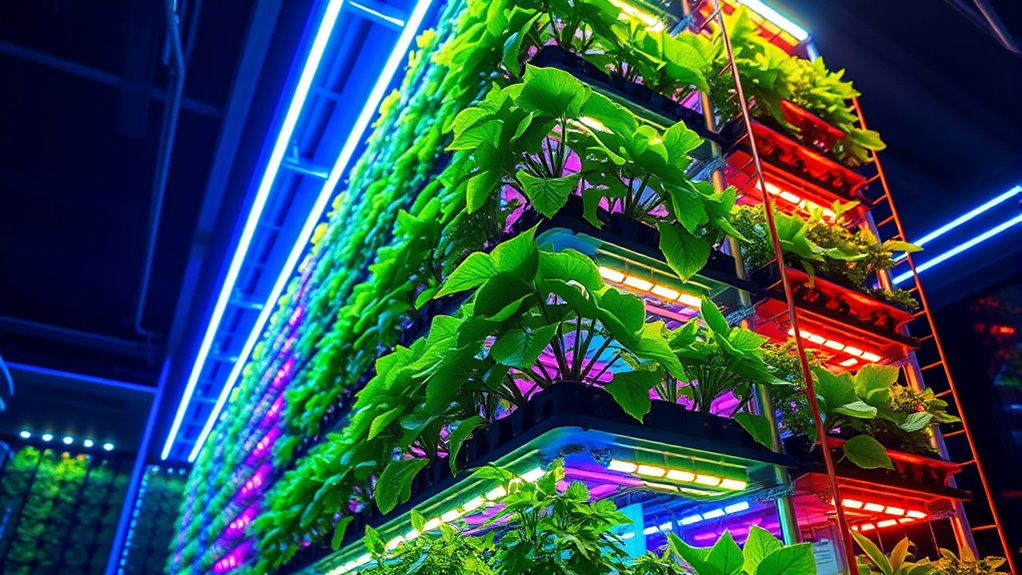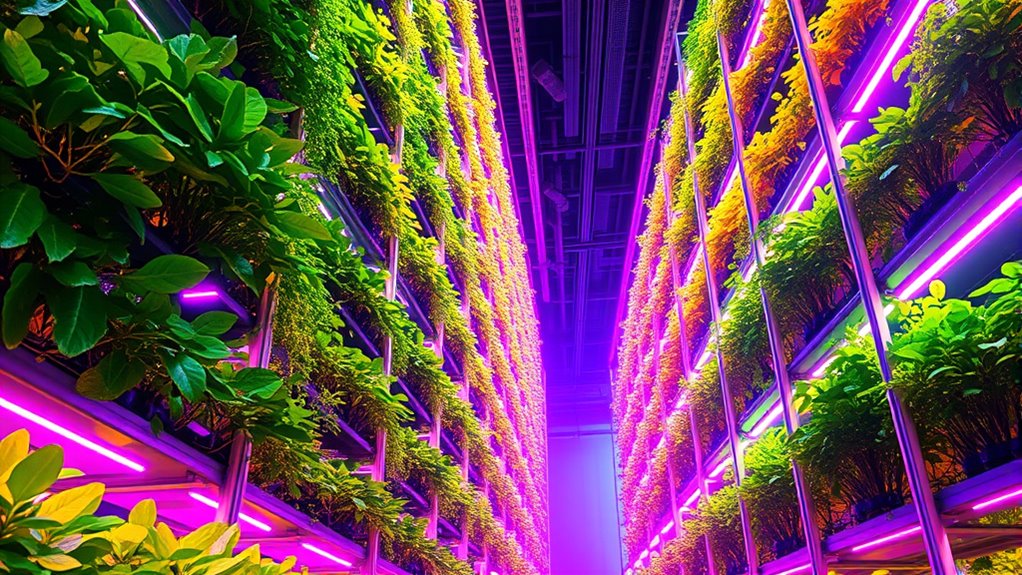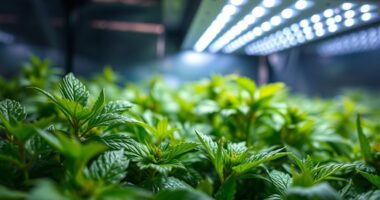Spectrum-controlled LED systems in vertical farming allow you to optimize light for each growth stage, leading to higher yields and better quality. Case studies show that adjusting spectra for specific crops, like leafy greens and strawberries, speeds up maturity and increases harvest size. This technology also improves resource efficiency, reducing energy costs. If you explore further, you’ll discover how these tailored lighting setups are transforming crop production and pushing farming boundaries, making your approach more successful.
Key Takeaways
- Case studies show spectrum-controlled LEDs accelerate plant growth and improve crop yield quality.
- Adjusting light spectra during growth stages enhances harvest efficiency and maturity speed.
- Tailored spectra optimize environmental conditions, leading to higher yields in vertical farm setups.
- Energy-efficient LED configurations reduce operational costs while maintaining high productivity.
- Empirical evidence links spectrum manipulation to improved crop variety performance and resource utilization.

Have you ever wondered how controlling light spectra can revolutionize vertical farming? It’s a game-changer that allows you to fine-tune environmental conditions to maximize crop yields and quality. Central to this innovation are LED configurations, which give you precise control over the light spectrum your plants receive. Unlike traditional lighting, LEDs can be adjusted to emit specific wavelengths, enabling you to optimize plant growth in ways previously impossible. This targeted approach ensures that your plants get exactly what they need at each stage of development, reducing energy waste and boosting productivity.
Controlling light spectra with LEDs transforms vertical farming by optimizing growth and boosting yields efficiently.
When you manipulate LED configurations, you’re essentially customizing the light environment for each plant species or growth phase. For example, blue light can promote vegetative growth, while red and far-red wavelengths encourage flowering and fruiting. By adjusting the intensity and combination of these spectra, you can create a tailored lighting recipe that accelerates growth, improves plant health, and increases yields. This method of plant growth optimization isn’t just theoretical; it’s backed by multiple case studies showing how spectrum-controlled lighting leads to faster maturity times and higher harvests compared to traditional setups.
In practical terms, implementing spectrum-controlled vertical farming means you can grow a wide variety of crops efficiently within a limited space. For instance, leafy greens like lettuce and spinach respond well to specific LED configurations that enhance leaf size and nutrient density. Similarly, fruiting crops such as strawberries or cherry tomatoes benefit from spectrum adjustments that optimize flowering and fruit production. This flexibility allows you to grow year-round, regardless of external weather conditions, and ensures consistent quality and quantity of your produce.
Moreover, spectrum control allows you to fine-tune environmental conditions to match the needs of different crops or growth stages. You can dynamically shift LED spectra as plants develop, ensuring optimal conditions throughout their lifecycle. This precision not only increases crop yields but also reduces energy consumption, making your vertical farm more sustainable and cost-effective. Additionally, understanding the spectral efficiency of different LED configurations can help optimize energy use and reduce operational costs. The ability to optimize plant growth through tailored light spectra is transforming vertical farming from a niche method into a mainstream agricultural practice. As you adopt this technology, you’ll see tangible results: faster growth cycles, higher yields, and better resource efficiency, all driven by the strategic manipulation of LED configurations and light spectra.
Frequently Asked Questions
What Are the Initial Setup Costs for Spectrum-Controlled Vertical Farms?
The initial setup costs for spectrum-controlled vertical farms vary based on your scale and technology choices. You should conduct a thorough cost analysis to estimate expenses accurately, including equipment investment like LED lighting, climate control systems, and sensors. Expect higher upfront costs due to advanced spectrum control technology, but remember, this investment can lead to increased yields and efficiency. Planning carefully helps you balance costs and benefits for a successful farm.
How Do Spectrum Adjustments Impact Crop Nutrient Uptake?
Imagine adjusting the light spectrum like tuning a musical instrument, creating the perfect harmony for your crops. When you modify the spectrum, you enhance light quality, which directly influences nutrient absorption. By optimizing light wavelengths, you enable plants to efficiently uptake nutrients, resulting in healthier growth. Spectrum adjustments become a powerful tool, allowing you to fine-tune conditions and maximize crop yields through improved nutrient uptake.
What Are the Long-Term Energy Savings of Spectrum-Controlled Systems?
You’ll find that spectrum-controlled systems substantially boost lighting efficiency over time, leading to notable long-term energy savings. By optimizing light wavelengths for plant growth, these systems reduce energy consumption and improve crop yields. As a result, you’ll experience a quicker energy payback period, making vertical farming more sustainable and cost-effective in the long run. This approach ultimately minimizes your operational costs while maximizing productivity.
Can Spectrum Control Optimize for Pest Resistance?
You can definitely use spectrum control to optimize for pest resistance. By manipulating the spectrum of light, you influence plant growth and defense mechanisms, making crops less attractive or vulnerable to pests. Spectrum manipulation enables you to target specific wavelengths that boost natural pest resistance traits, reducing the need for chemical pesticides. This approach helps you create a more resilient crop system and promotes sustainable farming practices.
How Scalable Are Spectrum-Controlled Vertical Farming Technologies?
Did you know vertical farming is projected to grow at a CAGR of over 24% through 2030? Spectrum-controlled technology is quite scalable, allowing you to tailor lighting for larger operations. While genetic modification can enhance crop resilience, market analysis shows increasing demand for sustainable, controlled environments. You can expand these systems efficiently, making them suitable for both small-scale and commercial farms, ultimately boosting food security and reducing environmental impact.
Conclusion
So, next time you marvel at those lush, perfectly grown greens, remember—they’re probably just a few LEDs away from being “spectrum-controlled marvels.” Who knew that controlling light could turn farming into a high-tech game of color-by-numbers? Maybe someday, your local farm will be just a fancy, indoor version of a disco—minus the dancing, plus a hefty bill for all those pixels. Welcome to the future, where even vegetables get their glow-up.









